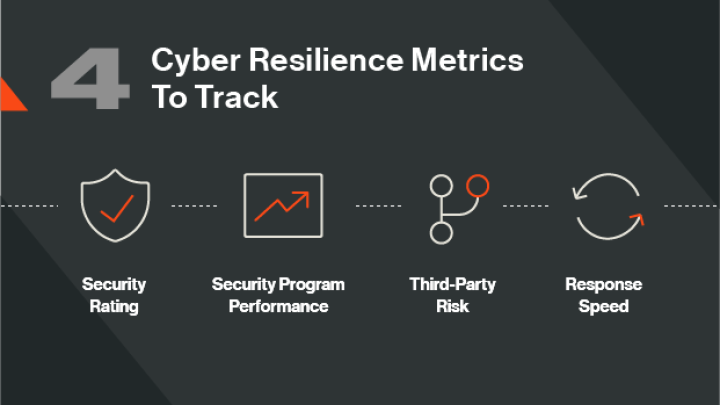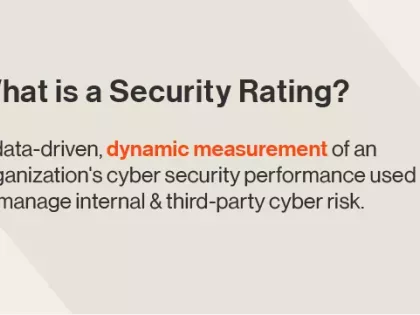4 Cyber Resilience Metrics You Should Be Tracking

Measuring Cyber Resilience
Cyber resilience is about reducing risk in your network, while ensuring that your organization can recover from threats—without a negative impact on the business. Rather than focusing solely on preventing cyberattacks, organizations working toward cyber resilience also invest in systems and practices that will ensure business continuity during attacks and allow them to recover quickly when attacks have been remediated.
To improve cyber resilience, you must first measure it. Cyber resilient metrics can provide crucial insights into the threats you face, the performance of security controls, and your ability to recover after an attack. These metrics also support conversations with the board about the effectiveness of your cybersecurity program.
Based on our extensive experience of data-driven risk insights, here are four key cyber resilience metrics you must measure.
Cyber Resilience Metric #1: Security Rating
One of the most effective cyber resilience metrics that you can use to inform better cybersecurity decisions are Bitsight Security Ratings.
Bitsight uses expansive data-scanning technology to provide an outside-in view of your organization's security posture. Findings are presented as a numerical score (like a credit score) ranging from 250 to 900, with a higher rating equaling better cybersecurity performance.
To see the power of security ratings at work, take a look at this study that Bitsight researchers conducted into the correlation between a low security rating and ransomware risk. The data shows that organizations with a rating lower than 600 are nearly seven times more likely to be a ransomware victim than those with advanced ratings. Digging deeper into those metrics, Bitsight also evidenced a clear link between individual risk vectors, notably unpatched and/or misconfigured systems.
Cyber Resilience Metric #2: Security Program Performance
A data-backed view of cybersecurity performance is essential to measuring cyber resilience, but you also need to understand where risk lies in your digital environment and remediate it.
With Bitsight for Security Performance Management (SPM), you can continuously monitor your digital footprint for emerging risk—in the cloud, on-premises, and across business units, geographies, and remote locations. Bitsight monitors for unpatched systems, misconfigurations, open access ports, malware infections, behavior anomalies, exposed credentials, and more—all of which contribute to a lower security rating. Plus, you’re alerted to problems right away for rapid remediation.
To further enhance resilience, use Control Insights, part of SPM, to drill down into the root cause of vulnerabilities, better understand a control’s state, and receive a recommended course of action based on CIS controls and/or safeguards.
You can also use Bitsight to plan and measure improvement over time. With the insights that Bitsight provides, you can align investments and actions where they will have the highest measurable impact for your security program, as well as facilitate data-driven conversations around cybersecurity with key stakeholders.
If more improvement is needed, use Bitsight Forecasting to model scenarios and see how a change in strategy, tooling, or resource allocation will influence security posture.
Cyber Resilience Metric #3: Third-Party Risk
Third-party risk is one of the leading causes of data breaches. But traditional methods of assessing and measuring your vendors’ security postures only capture a point-in-time view of risk. They are also costly and time-consuming.
A better way to expose risk in your supply chain is to monitor the security performance of your vendor pool continuously and automatically—from onboarding through the life of the relationship. Using Bitsight for Third-Party Risk Management, you can gain unprecedented visibility into vendor risk. Bitsight’s risk management tools provide a near real-time view of a third-party’s security posture and alert you when new or emerging risks arise.
You can also refine your metrics by tiering vendors according to their criticality to your business and the inherent risk you’re willing to accept. Once you’ve completed this exercise (made easier using Bitsight’s tier recommender service), you can set alerts to ensure you’re notified when critical third parties experience a drop in their security performance.
Cyber Resilience Metric #4: Response Speed
The ability to restore a system’s functionality after a cyber attack is critical to ensuring continuity of operations. Being prepared and ensuring you have a cyber resilience framework in place can help ensure rapid recovery.
But you must also extend your response efforts to your vendors and partners. When a breach occurs, hackers will often move laterally across the interconnected supply chain looking for sensitive data, seeding malware, and encrypting systems. Using Bitsight, you can arm your third parties with the insight and data they need to quickly assess their digital ecosystem for cyber risks and take appropriate action.
Building Cyber Resilience with Bitsight
Bitsight provides trusted data and insights that enable organizations to make better risk-based decisions. The Bitsight platform offers a suite of solutions that can help organizations achieve cyber resilience and reduce the impact of cyber risk.
Bitsight solutions are based on Bitsight’s industry-leading Security Ratings, a tool that organizations can use to proactively reduce risk throughout their attack surface. Ratings are based on objective, externally verifiable data points covering four areas of cyber risk: compromised systems, user behavior, security diligence, and publicly disclosed data breaches. By analyzing and weighting 100 billion new events each day, Bitsight produces daily security ratings for 40 million+ organizations worldwide.
Providing an outside-in view of the security posture of organizations and their third-party portfolio, Bitsight Security Ratings take the guesswork out of measuring security performance.


